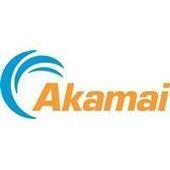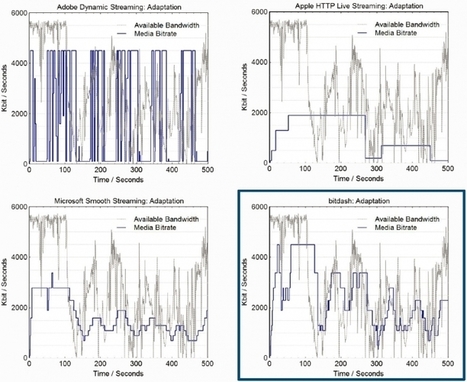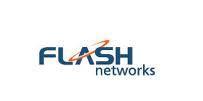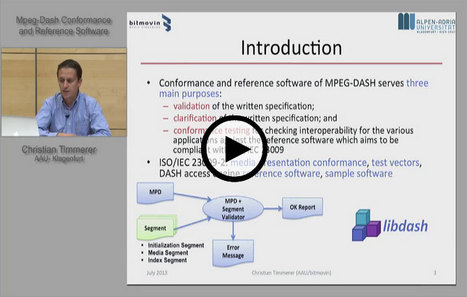 Your new post is loading...
 Your new post is loading...
Presentation by Romain Bouqueau (GPAC Licensing) during @OVFSquad Hangout - March 2014
A heavyweight panel that included Google, Microsoft Open Technologies, and Digital Primates guided Streaming Media West attendees through the creation of an open source DASH-AVC/264 player. Will Law, chief architect for Akamai, moderated and kicked off the discussion.
"We're trying to cook up something delicious here, and we have three ingredients to do it. We've got MPEG-DASH, we've got MSE/EME, and we've got dash.js," Law began. "You may not know what these are. I'm going to describe very briefly what our core ingredients are, and then we'll see how they're mixed by our panelists."
There is hope on the horizon. MPEG-DASH exists as an open alternative to these closed standards. Two of the three companies with proprietary closed standards have been actively involved in the formation and promotion of DASH. These efforts have been clearly successful, as DASH delivery of content is becoming more and more prevalent – for example, Netflix, Hulu and YouTube have all released versions of their content via DASH delivery. Through the efforts of Browser manufacturers, Media Source Extensions (another open standard), have become available in many browsers allowing delivery of DASH content without any additional plugins required. Unfortunately, HLS remains the most common delivery format in the US, and Apple (the author/owner of HLS) has shown no interest in supporting MSE in their browser. A tipping point is clearly on the way, which will see a massive growth in DASH delivery. Eventually Apple will be forced to embrace the current open standard, or risk losing content which has made their platform so appealing. The irony of course is that Apple has done so much marketing touting themselves as leaders of the “open web” movement, and they are the long holdout stalling the success of this open standard.
Poor quality streaming video solutions resulted in an estimated $2.16 Billion of lost revenue in 2012 (according to the2013 Conviva Viewer Experience Report). That’s a LOT of zeros! Since we at Microsoft Open technologies, Inc. (MS Open Tech) believe this is simply unacceptable, we’d like to share some ways in which developers can leverage open source code to ensure their own delivery of video is of the highest possible standard. For this tutorial, we have chosen to use the dash.js player to deliver MPEG-DASH video to any browser that supports the W3C Media Source Extensions (MSE).
Advanced Digital Broadcast (ADB) today announced that it is first to market with a commercial MPEG-DASH (Dynamic Adaptive Streaming over HTTP) implementation, making standardised video delivery via the internet a reality for the first time. The MPEG-DASH implementation, along with a Common Encryption (CENC) scheme using Intertrust Technologies’ Marlin DRM, forms part of ADB’s new, ready-to-deploy OTT solution for video service providers looking for a high quality, standards-based OTT solution. The first OTT service which uses tivùon! technology is Infinity, from Mediaset, which went live in Italy on December 11th. Customers with existing ADB-powered HD set-top boxes (i-CAN 1850S, 2850ST, 3820T) received an automatic over-the-air software update, adding support for MPEG-DASH and allowing them to enjoy the Infinity service from day one. All new Italian i-CAN HD set-top boxes will feature the new software.
MPEG DASH was created to deal with a highly fragmented media streaming ecosystem struggling with fragmentation and lack of interoperability of many proprietary solutions. Still that fragmentation has not stopped video to grow to being over half of mobile, and almost three-quarters of fixed traffic (YE2012). But this situation very negatively impacts on the one hand technology scale and cost advantages in the industry, and on the other hand the end user experience, engagement and (advertising) revenues that keep the media wheel spinning. Enter MPEG DASH - the industry-defined open standard for media streaming that has gained strong industry support. Many suppliers have announced support for MPEG DASH though broad, real-world deployment is still a few years out.
bitmovin's CIO Dr. Christian Timmerer regularly attends the standardization meetings of the Moving Picture Experts Group (MPEG). This is his report from the 106th MPEG meeting in Geneva, Switzerland ...
While NAB 2012 was approaching, Will Law was pushing forward MPEG-DASH on this blog as "a single [video] format that can be supported across a common ecosystem of content and services, all the way from the encoder down the chain to the end consumer" with the potential to "translate into an industry with a deeper feature set and a steeper innovation curve". What is the situation after IBC 2013? Did MPEG-DASH successfully handle this industry spread to allow a world of streamlined media workflows? Let's agree that the general perspective provided by MPEG-DASH is quite appealing for most online video professionals, with the target of drastically reducing the number of Adaptive Bitrate streaming formats to support. The recent move of Widevine dropping proprietary packaging in favor of DASH clearly goes in this direction, as well as the positive efforts of Microsoft to translate Smooth Streaming to DASH through a new generation of PlayReady DRM and new DASH-enabled player frameworks. After having recently focused on HLS support in its client implementations, Adobe now gets back to DASH with announcement of early 2014 support, which will be a major event if DASH finally comes to the huge installed basis of Flash Players and supersedes Adobe HDS format.
Flash Networks, the leading provider of mobile Internet optimization and monetization solutions, announced the availability of MPEG-DASH video optimization that reduces network congestion and improves the quality of experience for subscribers without manipulating video content. Flash Networks' MPEG-DASH optimization solution is part of the company's advanced video optimization solution that provides 30%-50% data reduction with no perceptible impact on video quality. Today a significant amount of YouTube traffic is delivered using the MPEG-DASH format. Dynamic Adaptive Streaming over HTTP (DASH), developed under the Moving Picture Experts Group (MPEG), is an open international standard designed to replace multiple vendor solutions to simplify the process of streaming video to the ever-expanding variety of video viewing devices. The companies participating in the MPEG-DASH standardization include Microsoft, Apple, Netflix, Qualcomm, Ericsson, Samsung, and many others. YouTube has implemented a unique flavor of MPEG-DASH that requires more sophisticated methods of optimization than standard MPEG-DASH. Optimization solutions that do not support MPEG-DASH are unable to positively influence the delivery of video with this format and therefore are less efficient overall. Flash Networks, by using proprietary methods, provides an advanced MPEG-DASH optimization solution, enabling mobile operators to provide a more consistent, higher quality of experience to its subscribers. "Providing exceptional video quality is a huge challenge given the varying types of mobile video traffic that need to be optimized," said Ofer Gottfried, Chief Technology Officer at Flash Networks. "At Flash Networks, we continue to invest in research to lead the industry in providing cutting edge mobile video optimization to enable mobile operators to stand out in the crowd and earn lasting subscriber loyalty." Harmony Video Optimization enables operators to optimize video traffic based on various parameters including date and time, network congestion, and subscriber information. Due to highly efficient transcoders and a unique system architecture, Harmony Video Optimization has a low footprint, resulting in a solution that is up to five times more cost-effective than other solutions. Flash Networks does not limit its optimization to a pre-selected list of sites, but sits at the heart of the network, inspecting, identifying, and then optimizing video traffic for a superior browsing experience and maximum data reduction.
Read more here: http://www.sacbee.com/2013/10/22/5841297/flash-networks-the-first-to-boost.html#storylink=cpy /PRNewswire/ --
Christian Timmerer and Carsten Griwodz. 2012. Dynamic adaptive streaming over HTTP: from content creation to consumption. In Proceedings of the 20th ACM international conference on Multimedia (MM '12). ACM, New York
MPEG-DASH Part 1, Media presentation description and segment formats by Thomas Stockhammer
MPEG-DASH, Part 2, Conformance and Reference Software by Christian Timmerer
In this article, I am going to cover one of the most common questions in the multimedia field: what is a standard and what does it cover? Once you have read this article, you will notice how often people, even the most influential ones, use some approximate wordings. Confusion leads to a lot of misunderstanding, so it’s good to review the subject. A recurrent misinterpretation is about open-source software and open standards. In this article, I will take the AVC/H264 codec as an example. Beside the coverage of a standard, I’d like to explain how standards link one to the other. I will use the examples of MPEG-DASH and the ISOBMF/MP4 container. Then I will show what the MPEG-DASH standard is really about.
With free-to-air broadcasters increasingly looking to hybrid solutions, combining broadcast with IP-based advanced interactive services to stay relevant, Europe’s HbbTV standard is evolving to enable a wider range of applications. Stuart Thomson reports.
Presentation discusses various aspects of IPTV delivery and relationship with H.265 (HEVC), HTML5 and other latest technologies.
Presented during IMTC 20th Anniversary Forum in Porto, Portugal
|
The Google Cast SDK is simple to integrate because there’s no need to write a new app. Just incorporate the SDK into your existing mobile and web apps to bring your content to the TV. You are in control of how and when you develop and publish your cast-ready apps through the Google Cast developer console. The SDK is available on Android and iOS as well as on Chrome through the Google Cast browser extension.
For non-media applications, or for more flexibility and design options, you can build your own custom receiver application using standard web technologies. With a custom receiver you can build virtually any application while including support for many streaming protocols, including MPEG-DASH, HLS, and Microsoft Smooth Streaming, all of which are available in the Media Player Library.
The text of ISO/IEC 23009-1 2nd edition PDAM1 has been approved which may be referred to as MPEG-DASH v3 (once finalized and integrated into the second edition, possibly with further amendments and corrigenda, if applicable). This first amendment to MPEG-DASH v2 comprises accurate time synchronization between server and client for live services as well as a new profile, i.e., ISOBMFF High Profile which basically combines the ISOBMFF Live and ISOBMFF On-demand profiles and adds the Xlink feature.
Additionally, a second amendment to MPEG-DASH v2 has been started featuring Spatial Relationship Description (SRD) and DASH Client Authentication and Content Access Authorization (DAA).
Other DASH-related aspects include the following:
- The common encryption for ISOBMFF has been extended with a simple pattern-based encryption mode, i.e., a new method which should simply content encryption.
- The CD has been approved for the carriage of timed metadata metrics of media in ISOBMFF. This allows for the signaling of quality metrics within the segments enabling QoE-aware DASH clients.
Hulu has already moved ahead on MPEG-DASH, but you'll have to get Google's $35 connected TV dongle if you want to try it. All of Hulu's Chromecast streaming uses DASH, Baptiste Coudurier, principle software development lead at Hulu, told the audience at the recent Streaming Media West conference in Huntington Beach, California. "We are actually using DASH in production right now on the Google Chromecast device, and we definitely see it as the future of on-demand delivery," Coudurier said. "It's 100 percent of the content, every piece of content that you watch on Google Chromecast is using MPEG-DASH."
Via Olivier NOEL
Wowza® Media Systems, provider of Simply Powerful StreamingTM media server software, today announced it is collaborating with DivX to demonstrate real-time encoding and decoding of DivX Live streaming in up to HD 720p resolution using the HEVC/H.265 codec over MPEG-DASH. The demonstration is powered by the latest MainConcept HEVC SDK, version 2.0, and is one of the first of its kind to enable live streaming for DivX-compatible HEVC/H.265 over MPEG-DASH.
The Wowza-enabled solution is designed to automatically transcode a single MPEG-TS H.264 720p incoming stream in real time to a set of DivX Live H.265-over-DASH adaptive streams.
The W3C HTML working group is developing media extension specifications for HTML5 to enable the delivery of commercial video to consumers over the Web. One of these is the Encrypted Media Extensions (EME) specification. The current specification describes an open interface which may be used to implement an EME-compliant Content Decryption Module (CDM) within a User-agent, providing access to a platform DRM component which supports the defined Content Decryption Module interface (CDMi).
I'm pleased to announce MPEG-DASH support in nginx-rtmp-module. Browser-side support in implemented in dash.js library.
Setting up nginx-rtmp-module
Check out dash branch of nginx-rtmp-module. Dash configuration is similar to HLS
location /dash { root /tmp; } ... application myapp { live on; dash on; dash_path /tmp/dash; } Dash module will create m4v, m4a, mpd files in its directory.
MPEG-DASH introduced open standards into HTTP streaming but did not include the client application as part of their standards. Online video player developers have been left to fend for themselves in determining how best to build the client side applications to consume DASH content. This article discusses the current state of online video, delves into the DASH standard, explores the challenges of building a DASH player, and, finally, walks through the basics of implementing the open source Dash.js player.
Une présentation OVFSquad de Nicolas Weil le 17/10/13.
Les thèmes abordés :
- panorama du support par l'industrie
- facteurs d'adoption et freins
- analyse du processus de standardisation
- avancées en Common Encryption + Multi-DRM
- point sur les players et HbbTV 1.5
- topo sur les prochains gros dossiers : HEVC, Multichannel audio et QoS
- point sur les déploiements actuels et annoncés
Regoignez OVFSquad sur LinkedIn
http://www.linkedin.com/groups?home=&gid=4509529
Nicolas Weil, Digital Media Solutions Architect (France, World), provides a nice blog post about the post-IBC'13 MPEG-DASH ecosystem status which highlights also the DASH timeline referred to as "The ABR Esperanto: On the road to standardization..." (ABR stands for adaptive bit rate)
The former provides not only an excellent overview about the status quobut also an implementation directory of products and services supporting DASH (incl. our award-winning bitdash & bitcodin). The latter shows the history of MPEG-DASH from back in 2010 - when standardization started - until now ... but what's next?
Dynamic Adaptive Streaming (DASH) is a technology that has been implemented and deployed although the scientific literature was inexistent. Simply put, the server offers several representations of the same video ; clients can choose the representation that best fit their capacities. Since 2008, many researchers have deciphered the global behavior of client-based adaptive mechanisms. However, one key piece of the theoretical cake is still missing: what is the optimal set of video representations the server should offer?
MPEG-DASH is the ABR Esperanto. Find out how this major video standard was built since 2011, with crucial contributions from Netflix, Microsoft, GPAC, Alpen Adria University ITEC Institute, DASH Industry Forum, HD Forum, Bitmovin or USP, under the joined standardization efforts of MPEG consortium and ISO, in collaboration with complementary standards from ITU, W3C...
|
 Your new post is loading...
Your new post is loading...
 Your new post is loading...
Your new post is loading...















![What’s new on the DASH frontier? [Report from the 107th MPEG meeting] | Video Breakthroughs | Scoop.it](https://img.scoop.it/lwafwczWHXVrfb8iwkwVrTl72eJkfbmt4t8yenImKBVvK0kTmF0xjctABnaLJIm9)









